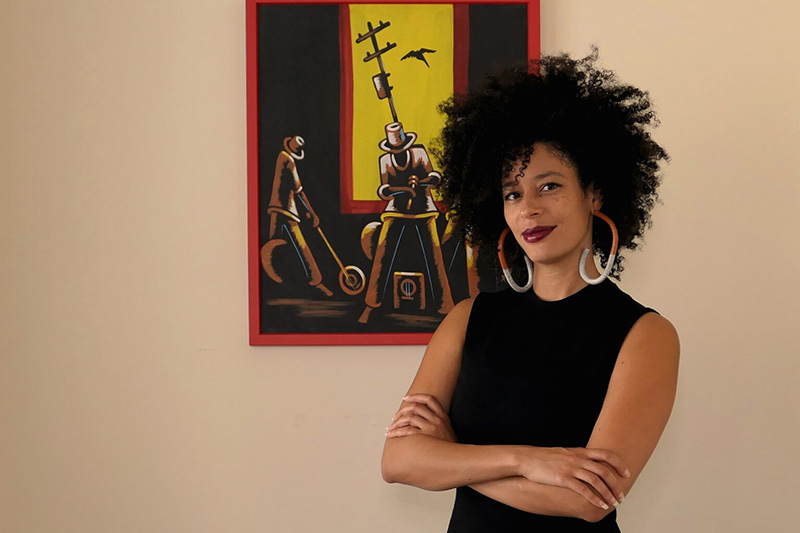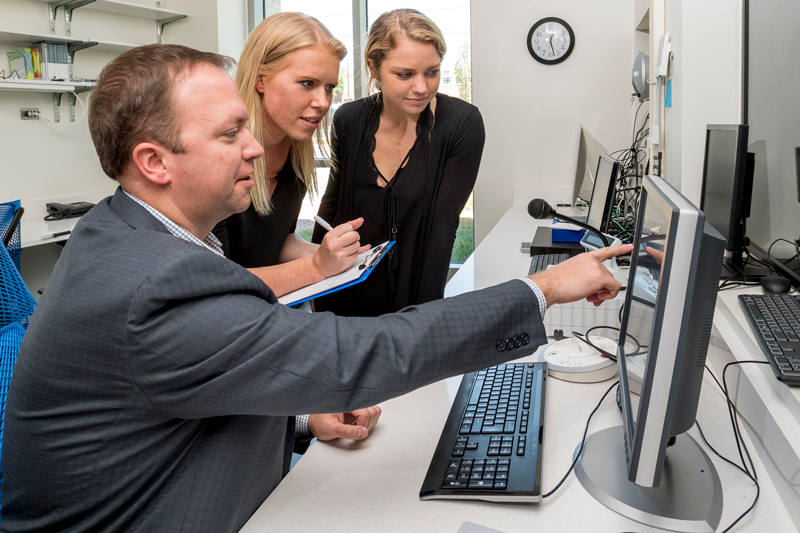


Mangone Young Scholars
Photos by Kathy F. Atkinson and Jawara King | Photo illustration by Jeffrey C. Chase December 21, 2021
Stellar early-career professors at UD recognized
Like young stars in the galaxy, University of Delaware Professors Tiffany E. Barber and Curtis Johnson are so luminous and bursting with energy you want to be in their orbit.
In the few short years since they joined the UD faculty, Barber and Johnson have been making a major mark in their respective fields. So much so that the University of Delaware’s Francis Alison Society has selected Barber, assistant professor in the College of Arts and Sciences, and Johnson, assistant professor in the College of Engineering, to receive the 2021 Gerard J. Mangone Young Scholars Award. Recipients are chosen by fellow faculty members who have received the Francis Alison Award, the University’s highest competitive faculty honor.
Barber is driving research at the intersection of art history and the study of Black life that is yielding fresh, new perspectives for interpreting Black representation in visual art, performance and film, and Johnson is pioneering a new technique to examine brain stiffness and how it relates to cognitive loss and diseases like Alzheimer’s.
To say the academic world has been paying attention to the achievements of these two scholars would be an understatement.

Tiffany Barber
“In the field of art history and African American art history in the U.S., it is generally known that Dr. Barber is one of the brightest and most distinguished young stars,” said Wunyabari Maloba, chair of the Department of Africana Studies, who nominated her for the award. “She commands tremendous respect, attention and admiration across the field.”
Since joining the UD faculty in 2018, Barber has been working to expand the world view of 20th- and 21st-century American art, African American art and their histories. She has special interests in the arts and cultures of the Black diaspora, women in art, aesthetic criticism and theory, the erotics of race, and theories of publics and public space.
“I want to inspire new ways of seeing the value of Black study and art history,” Barber said. “I also encourage my students to challenge their own preconceived notions about representation by assessing how they, as consumers and makers of art and culture, fit into an increasingly uncertain, image-saturated world.”
A major focus of her work has been to present and implement new modes of criticism and theory for interpreting artists of the Black diaspora.
“There are reductive ideas about race and representation that constrain Black artists,” Barber said. “A lot of times critics expect Black artists to restrict themselves to racial empowerment and healing.”
Barber knew in middle school that she wanted to be a professor. Growing up, she was surrounded by the arts and creativity, thanks to her mom, who is an artist.
From this creative base, Barber pursued her first academic love — dance performance — which she earned a bachelor’s degree in. She said it helped her to think more about how she relates to the world, as well as to hone her visual analysis skills. That foundation, as well as experiences in arts administration and exhibition curation, served her well when she entered a doctoral program in art history in 2011 and soon began soaring as a scholar in the field.
Today, Barber is a highly sought lecturer, having given more than 50 invited presentations in the past few years on topics ranging from Black portraiture to Afrofuturism. She’s also spoken frequently about lesser-known Black artists, including painter and master printmaker Eldzier Cortor, who celebrated African American women through his art, including paintings of the Gullah community of the islands off the Georgia and South Carolina coasts, and Alma Thomas, a noted member of the Washington Color Field School, who took up painting seriously after a 38-year career as an art teacher in public schools in Washington, D.C.
Barber has presented on her scholarship locally at Winterthur Museum, Delaware Art Museum, The Delaware Contemporary and Biggs Museum of Art, and at locations across the U.S. in person or virtually, from the Metropolitan Museum of Art to Stanford, and dozens of other universities, museums, arts and cultural organizations, and media.
Recently, Barber was selected to receive the prestigious Scholar in Residence award from the Getty Research Institute to work on her upcoming book, “Undesirability and Her Sisters: Black Women’s Visual Work in the New Millennium,” which examines the art and activism of Kara Walker, Wangechi Mutu, Xaviera Simmons and Narcissister at the turn of the 21st century.
She began her residency at The Getty, in Los Angeles, California, this past September and will return to UD next summer, where her students will continue to gain new understandings of struggle and progress, to “break down and potentially fashion new terms for themselves,” through her teaching.
“As digital natives, my students already have an understanding of our image-saturated world, and they are making new media every day, whether it’s a TikTok video or a Tweet,” Barber said. “I approach my teaching in the same way that I learned — through making things collaboratively, whether it’s an exhibition or a performance score or a music video – and being in conversation with living artists. It’s really such a thrill.”
Barber’s work is already having an impact. What does she hope it will eventually lead to?
“I hope that my work will contribute to a more inclusive art history that incorporates Black Studies,” she said, “to help realize a world where artists of African descent can self-determine and fashion their careers on their own terms.”

Curtis Johnson
Becoming a professor was not really Curtis Johnson’s goal. He saw it as a logical step. He followed what struck him as cool when he was a student and excelled at research. Then as a postdoc, he found he enjoyed working with students.
“If you like what you’re doing, it’s the path to do what you like doing,” said Johnson, who joined the faculty of UD’s Department of Biomedical Engineering in 2016. In addition to the appeal of being part of a dynamic group of UD faculty who work well together, Johnson was attracted to UD because of its MRI scanner, the only one in the state of Delaware dedicated to research. And he’s certainly been putting the scientific instrument through its paces — by pioneering a new technique to assess brain health.
“In his short time at UD, Curtis Johnson has proven himself to be an extremely talented and successful researcher, as well as a collaborative and dedicated faculty member and mentor,” said Kristi Kiick, Blue and Gold Distinguished Professor and chair of the Department of Biomedical Engineering, who nominated him for the award. “Dr. Johnson is one of the foremost leaders in brain magnetic resonance elastography and supplies the technology to perform these experiments to other researchers around the world.”
What’s magnetic resonance elastography (MRE), you say? Invented by researchers at the Mayo Clinic, it combines MRI imaging with low-frequency vibrations to create a visual map showing the stiffness of body tissues.
Originally used to detect stiffening of the liver caused by chronic liver disease, the technique has been developed by Johnson and his team to study the brain in a non-invasive way. They hold several patents for this leading-edge work.
What they have found is that subtle differences in tissue stiffness and viscosity predict cognitive function and are more sensitive than other neuroimaging methods. They have built on these findings to examine brain health in aging and mild cognitive impairment, development and neurodevelopmental disorders, and modeling of traumatic brain injury.
“We have a very interesting tool for studying brain health sensitively, to understand the brain better,” Johnson said.
Based on Johnson’s research, the stiffer your brain, the better your memory.
“Mechanically, your brain is like reinforced concrete, with the axons like bundles of fibers embedded inside to make it stiff. But then it gets structurally weaker, and you can see this breaking down before other things happen. It’s a lot like fruit,” Johnson said, “it’s firm at first and then decays when ripe.”
Johnson already has received more than $7 million in competitive research grants from the National Science Foundation, National Institutes of Health and Office of Naval Research, and he has been an author on 66 research papers — 49 of them written at UD and published in top neuroimaging journals including Cerebral Cortex, NeuroImage, and Human Brain Mapping.
He is now exploring the impact of life-style interventions and immunotherapies on brain stiffness. One large study is assessing how exercise affects memory function, and several other studies led by his students are underway.
Johnson also is graduate director for the growing biomedical engineering department, which had 20 graduate students when he joined the faculty five years ago and now has 70.
He and his colleagues place a premium on developing a variety of mixers and other events to bring the department together and prevent the tunnel vision that can often happen to graduate students.
The graduate students in his own group have thrived, publishing manuscripts and winning awards, and five of the undergraduate students he has mentored have completed honors theses and are continuing their education at other top graduate schools.
“I have an incredible group, and we have great collaborators — folks at Dartmouth and Washington University at St. Louis. I think we’ve done well with the opportunities that have come,” he said.
Worldwide, few groups are developing MRE technologies. Johnson said he and his team are committed to sharing their work to propel the field forward.
“The ultimate goal is to get this technology and our findings used in other people’s research,” he said.
About Gerard J. Mangone
The Mangone Young Scholars Award is named in honor of the late Gerard J. Mangone, a pioneering international legal scholar who joined the UD faculty in 1972 and spent nearly the next 40 years teaching and advising scores of UD students. He also served numerous governmental and non-profit organizations, consulting for the White House, the State Department, the United Nations, Japan, the Ford Foundation and the Carnegie Endowment for International Peace. He was the first senior fellow at the Woodrow Wilson International Center for Scholars in Washington, D.C., and served as a visiting professor and lecturer around the world. Dr. Mangone’s contributions were instrumental to the success of UD's marine policy program. He founded the Center for the Study of Marine Policy, the first research center at an American university to study the legal, political and economic issues facing the ocean and coast. The center was the forerunner of the Gerard J. Mangone Climate Change Science and Policy Hub. He received UD’s highest faculty honor — the Francis Alison Award — in 1983 and was an active member of the Francis Alison Society until his passing in July 2011.
Contact Us
Have a UDaily story idea?
Contact us at ocm@udel.edu
Members of the press
Contact us at 302-831-NEWS or visit the Media Relations website

